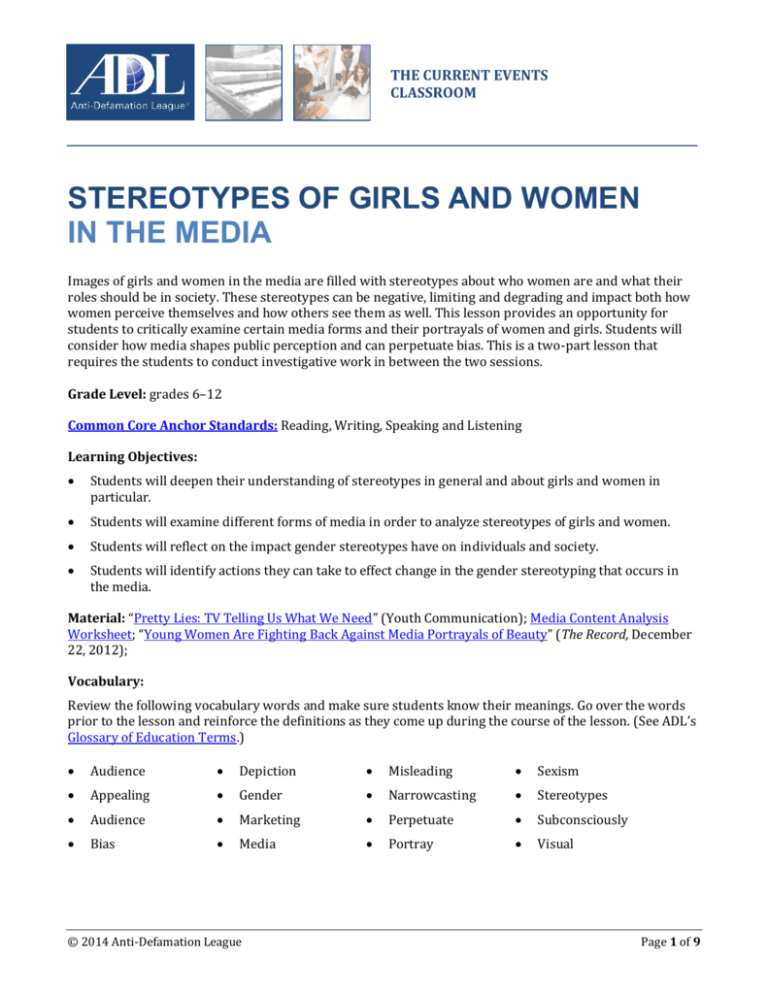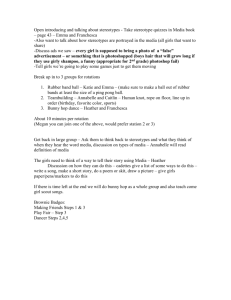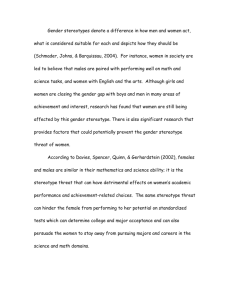Stereotypes of Girls and Women in the Media
advertisement

THE CURRENT EVENTS CLASSROOM STEREOTYPES OF GIRLS AND WOMEN IN THE MEDIA Images of girls and women in the media are filled with stereotypes about who women are and what their roles should be in society. These stereotypes can be negative, limiting and degrading and impact both how women perceive themselves and how others see them as well. This lesson provides an opportunity for students to critically examine certain media forms and their portrayals of women and girls. Students will consider how media shapes public perception and can perpetuate bias. This is a two-part lesson that requires the students to conduct investigative work in between the two sessions. Grade Level: grades 6–12 Common Core Anchor Standards: Reading, Writing, Speaking and Listening Learning Objectives: Students will deepen their understanding of stereotypes in general and about girls and women in particular. Students will examine different forms of media in order to analyze stereotypes of girls and women. Students will reflect on the impact gender stereotypes have on individuals and society. Students will identify actions they can take to effect change in the gender stereotyping that occurs in the media. Material: “Pretty Lies: TV Telling Us What We Need” (Youth Communication); Media Content Analysis Worksheet; “Young Women Are Fighting Back Against Media Portrayals of Beauty” (The Record, December 22, 2012); Vocabulary: Review the following vocabulary words and make sure students know their meanings. Go over the words prior to the lesson and reinforce the definitions as they come up during the course of the lesson. (See ADL’s Glossary of Education Terms.) Audience Depiction Misleading Sexism Appealing Gender Narrowcasting Stereotypes Audience Marketing Perpetuate Subconsciously Bias Media Portray Visual © 2014 Anti-Defamation League Page 1 of 9 The Current Events Classroom adl.org/curriculum-resources PART I WARM UP: WHAT IS MEDIA? 1. Have students take out paper and ask: In the last 24 hours, what different forms of media did you use or interact with? 2. Instruct students to write down as many forms of media as they can think of. Give students a few minutes to make their lists and do not define the word media in advance (it will be defined later). After the time is up, have students share what they wrote. They will likely include some but not all of these: TV shows podcasts TV news magazines (paper or online) radio music videos TV commercials newspapers (paper or online) internet ads on apps or computer games social media movies online news internet shows billboards YouTube video video games 3. Ask students: What is media? Work with students to come up with a definition of media as follows: Media is “communication channels through which news, entertainment, education, data, or promotional messages are disseminated. Media includes every broadcasting and narrowcasting medium such as newspapers, magazines, TV, radio, billboards, phone and internet.” (BusinessDictionary.com) Based on the definition, have students add other forms of media not included previously. 4. Tell students they are going to discuss stereotypes about girls and women and will investigate how they are portrayed in the media. UNDERSTANDING STEREOTYPES 1. Ask students: What is a stereotype? Help students come to the following definition of stereotype: Stereotype is an oversimplified generalization about a person or group of people without regard for individual differences. Even seemingly positive stereotypes that link a person or group to a specific positive trait can have negative consequences. 2. Have students think of a time when someone made an assumption about them based on an aspect of their identity or perceived identity such as gender, race, ethnicity, age, physical or mental ability, physical appearance, sexual orientation, religion, economic status or some other characteristic. 3. In pairs, have students describe the assumption or stereotype and how it made them feel. After talking for a few minutes in pairs, have a few students share of the stereotypes aloud. 4. Ask: How was it to talk about a stereotype you experienced? How do stereotypes perpetuate bias and prejudice? © 2014 Anti-Defamation League Page 2 of 9 The Current Events Classroom adl.org/curriculum-resources GENDER STEREOTYPES 1. Ask students: Did anyone select gender when they were talking about stereotypes? 2. Instruct students to share stereotypes about women and girls. Record their responses on the board in a semantic web (see illustration below for an example). Gossip Sexy Thin Pretty Focus on appearance Moms Girls & Women overly concerned relationships housewife takes care Stereotypes Relationships with romantic Primary caregiver Talks a lot of kids Emotional not good at math weak & science NOTE: Some students may feel reluctant to express stereotypes for fear that people will think they believe those stereotypes. Emphasize that the words students share do not necessarily reflect their actual beliefs but they underscore how deeply ingrained stereotypical thinking is in all of us. Assure students that they should share without fear of judgment. 3. Ask the following questions: Looking at these words and phrases on the web, what generalizations can you make about the stereotypes of girls and women? Are they mostly positive or negative? How do you feel looking at these words? What are the overall messages that are being conveyed about women and girls? 4. Explain to students that if we cluster these stereotypes, there are at least three general categories: a. Women and girls are weak, emotional, helpless, are not good at fixing things and tend not to be skilled in math and science. b. Women and girls are primarily concerned with relationships and, as they grow up, are more focused on romantic/love relationships and their roles as mothers and caregivers, sometimes at the exclusion of other aspirations. c. Women and girls must value their physical and sexual attractiveness first above everything else. They have to look flawless and the standards of beauty for women are very different than those for men (i.e. it is acceptable for men to have physical flaws, show signs of aging, be a normal weight or overweight, etc.). © 2014 Anti-Defamation League Page 3 of 9 The Current Events Classroom adl.org/curriculum-resources READING ACTIVITY: MEDIA PORTRAYALS OF GIRLS AND WOMEN 1. Tell students that they are going to discuss how these stereotypes of women and girls are perpetuated in the media. 2. Ask students: Can anyone give me an example of a stereotype of women or girls that is being portrayed in any of the media forms we talked about earlier? Ask for examples from the class. 3. Have students read “Pretty Lies: TV Telling Us What We Need” and after everyone has read it, use these questions to guide a whole class discussion: What is the meaning of the title “Pretty Lies: Telling Us What We Need?” Why was it difficult for Trisha (the author) and her family to figure out what product was being sold? What is the connection between the advertisement and the product, according to Trisha? How do advertisers use certain images to get people to buy products? In the advertisement Trisha describes at the beginning of the essay, what stereotyped portrayals of women were used? HOMEWORK ASSIGNMENT: MEDIA CONTENT ANALYSIS 1. Explain to students that for homework, they will investigate how women and girls are portrayed in various forms of media. They will then report their findings to the class a few days after they have done their research and analysis. Select five or six categories from the above list of media. For example: Television or Internet Show: Students will watch one hour-long show or two half-hour shows Movie: Students will watch one full length movie Magazine Advertisement: Students will look at five magazine advertisements Television Commercial: Students will watch five television commercials Web site: Students will look at one website and examine at least three separate pages YouTube videos: Students will watch five short (5 minutes or less) or one longer YouTube video NOTE: You may want to evenly and randomly assign students to the five or six types of media, but some students may not have access to certain media. Therefore, it is advisable to ask students to identify which form of media they want to investigate and make sure that all the groups are equally represented (this may involve some negotiation). 2. Distribute the Media Content Analysis Worksheet to each student. For students who will be looking at multiple advertisements, commercials or YouTube videos, give them five sheets to complete. Explain to students that because a television commercial is much shorter than a television show, students reviewing commercials will need to look at five instead of one. 3. Review the instructions and designate a date by which the assignment should be completed (3–5 days). © 2014 Anti-Defamation League Page 4 of 9 The Current Events Classroom adl.org/curriculum-resources PART II WARM UP Ask students to describe in one word how they felt observing and analyzing their media forms for stereotypes of women and girls. PROCESSING MEDIA ANALYSIS 1. Divide students into small groups by media category (e.g. all the students who analyzed television shows form a group, all students who analyzed a movie form a group, etc.). Have each group select a recorder and reporter. 2. Instruct group members to share information about the media that they analyzed, using their Media Analysis Content Worksheets to explain what they discovered. The recorder should write on chart or regular paper the major discussion points. 3. Reconvene the whole class and ask the reporters to provide a brief summary of their group’s discussion, using the notes on chart paper. After all the groups have reported, have a class discussion using some of the following questions: What stereotypes about girls and women did you find? What stereotypes about girls and women were dispelled? Were the stereotypes positive overall, negative overall or a combination? Were you surprised by your findings? Why or why not? Do you have any general thoughts or conclusions about how women and girls are portrayed in the media? What do you think is the impact of these messages on individuals (especially girls and women) and society at large? Do you think producers of media have a responsibility to portray women and girls in ways that defy stereotypes? Explain. Go back to the semantic web and the overall categories of stereotypes. Do your findings reflect those stereotypes? Are there additional portrayals? What did you learn by doing this activity? How can people (as the consumers of the media) avoid being manipulated by the media and not internalize the messages being conveyed about girls and women? TAKING ACTION: GENERATING IDEAS 1. Read aloud the article, “Young Women Are Fighting Back Against Media Portrayals of Beauty” or summarize the article by telling students: In December 2012, a 17-year-old New Jersey high school girl asked all the female students to show up for school without makeup, to feel good enough about themselves and, for one day, not try to look like a models or actresses. Another teenage girl from Maine started a change.org petition for Seventeen Magazine to “give girls images of real girls.” The magazine responded with a promise not to alter the body size or face shape of its models and to be more transparent in what they do to photos. © 2014 Anti-Defamation League Page 5 of 9 The Current Events Classroom adl.org/curriculum-resources 2. Have students get back into their small groups and discuss the last discussion question in more depth by asking the following questions: How can people (as the consumers of the media) avoid being manipulated by the media and not internalize the messages being conveyed about girls and women? What can we do to influence these companies to present a more balanced portrayal of girls and women? Write or project these two questions on the board. 3. Instruct each small group to come up with 3–5 ideas based on the specific media form they investigated. Have each group share at least one idea with the whole class. WRITING ACTIVITY: LETTER OF COMPLAINT OR PRAISE (OPTIONAL) In the Taking Action activity above, students may come up with the idea to write a letter of complaint to the company responsible for the television show, advertisement, website, etc. Either in class or for homework, have students write a letter of complaint or a letter of praise to the company who created the television show, ad, magazine, website, etc. Explain to students that it is just as important to affirm when the media gets it right and has a positive portrayal as it is to complain when we don’t like what they did. For example, students may want to write a letter to Lions Gate Entertainment and praise them for making a movie with a strong female lead character in The Hunger Games. In their letters, students should explain what they discovered in their analysis, how they reacted, what negative (or positive) portrayals of girls or women they saw and their suggestions for what the company should do to improve their portrayal of girls and women. In addition, instruct students to find the company information (name, address, CEO, etc.) in order to address the letter correctly. Go through the feedback and revision process to ensure that the letters are well written, comprehensive and thoughtful. Share some of the letters with the whole class. CLOSING Have each student describe something they learned. NOTE: Boys in the class may indicate that they also feel there are negative male stereotypes in the media and that they specifically have body image pressures on them. There are some resources below about this topic if you would like to extend the lesson and address those issues as well. ADDITIONAL READING Media Smarts: Women and Girls Media Smarts: Common Stereotypes of Men in Media “Gender stereotypes in mass media. Case study: Analysis of the gender stereotyping phenomenon in TV commercials” (Krytyka.org, January 9, 2011) “7 Ways Women and Girls are Stereotyped, Sexualized, and Underrepresented on Screen” (Mother Jones, November 30, 2012) Geena Davis Institute on Gender in Media (www.seejane.org) © 2014 Anti-Defamation League Page 6 of 9 The Current Events Classroom adl.org/curriculum-resources “Deception: How the Media Strengthens Women Stereotypes” (Kynagarr, November 27, 2012) “Barbie’s Sports Illustrated Swimsuit Issue Causes a Stir Online” (New York Times, February 11, 2014) Killing Us Softly 3: Advertising’s Image of Women (Top Documentary Films) “With Some Selfies, the Uglier the Better” (New York Times, February 21, 2014) “How do Media Images of Men Affect Our Lives?” (Media & Values 48) “Muscular Body Image Lures Boys Into Gym, and Obsession” (New York Times, November 19, 2012) © 2014 Anti-Defamation League Page 7 of 9 The Current Events Classroom adl.org/curriculum-resources COMMON CORE ANCHOR STANDARDS Content Area/Standard Reading Standard 2: Determine central ideas or themes of a text and analyze their development; summarize the key supporting details and ideas. Standard 7: Integrate and evaluate content presented in diverse media and formats, including visually and quantitatively, as well as in words. Writing Standard 4: Produce clear and coherent writing in which the development, organization, and style are appropriate to task, purpose, and audience. Standard 5: Develop and strengthen writing as needed by planning, revising, editing, rewriting, or trying a new approach. Speaking and Listening Standard 1: Prepare for and participate effectively in a range of conversations and collaborations with diverse partners, building on others’ ideas and expressing their own clearly and persuasively. Standard 2: Integrate and evaluate information presented in diverse media and formats, including visually, quantitatively, and orally. © 2014 Anti-Defamation League Page 8 of 9 The Current Events Classroom adl.org/curriculum-resources MEDIA CONTENT ANALYSIS WORKSHEET Directions: After describing the specific media you are analyzing, respond to the questions below as completely as possible. If you are looking at more than one (e.g. a few advertisements), complete a sheet for each media type. Be prepared to share your findings with the class. Media Category: _______________________________________________________________________________________________________ Title/Description of item you observed: _________________________________________________________________________ ___________________________________________________________________________________________________________________________ 1. Why would someone use/watch/read/engage with this form of media (to gain knowledge, to purchase a product, to be entertained)? 2. What audiences are being targeted? What makes you think that? 3. Were there girls or women present in the media form? If so, what role(s) did they play? 4. Are there any stereotypes about girls and women that are apparent? If so, explain the stereotype and how it is perpetuated. 5. Are there stereotypes about girls and women that were dispelled? 6. If you were re-doing this advertisement, TV show, etc. how would you remake it to have an improved portrayal of women and girls? © 2014 Anti-Defamation League Page 9 of 9





